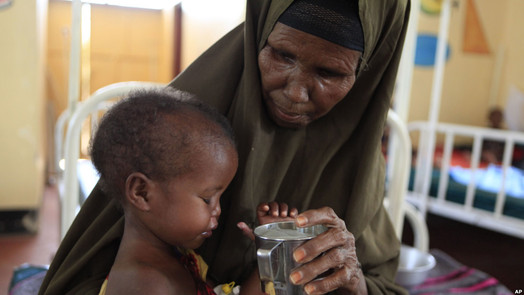
Children await death in Somalia
27 July 2011
Teams from the IHH Humanitarian Relief Foundation which went to Kenya in the wake of the problems in the region have moved to Somalia. IHH emergency aid teams first visited the camps in Mogadishu to figure out what could be done in the medium and long term and they launched relief efforts in the region immediately. IHH Emergency Aid Coordinator Recep Güzel who coordinates relief efforts in Somalia after Kenya said what he has witnessed in the camps is the preliminary signs of bigger disasters. Having joined many emergency relief efforts in many parts of the world, Güzel said he has never faced with such a tragedy.
Most deplorable scene I’ve ever seen in my life
Visiting the camps and a women’s-children’s hospital in Mogadishu, Güzel explained: “Following relief efforts in Kenya, we have come to Mogadishu to launch relief efforts here. I can describe the situation here as the end of the humanity. I have joined in emergency relief efforts in many troubled regions of the world but I have never seen such a picture. Since no aid is dispatched to the south of the country out of security concerns, people living there migrate to Mogadishu. There is 500-kilometer of distance for them to cover. People who were already exhausted by drought and hunger walk for kilometers under these circumstances.”
At least one from each family dies
Güzel said people who leave their houses to migrate to Mogadishu experience big problems during their journey to the capital city. “Some people lose their lives on their way to Mogadishu. At least one from each family dies during this challenging journey. Contrary to the situation in Kenya, there are smaller camps here. Around 150-200 families live in each camp,” he said.
It is so sad to wait for the death of a child
Stressing that it is the children again who are most affected by drought and hunger, Güzel shared his impressions from his visit to a women’s and children’s hospital as follows: “People who are able to make it to Mogadishu collapse from exhaustion. Their situation deteriorates due to inadequate nutrition. Let alone walking, women and children cannot even take one step. It is so sad to say this but children are like skeletons. The face of a child was not seen due to the small flies that covered his face in a hospital where we made examinations. He was receiving serum treatment but he was unable to keep his eyes stable. I have never felt myself so desperate throughout my life. A child was slowly dying in front of my eyes but I was able to do nothing to save him.”
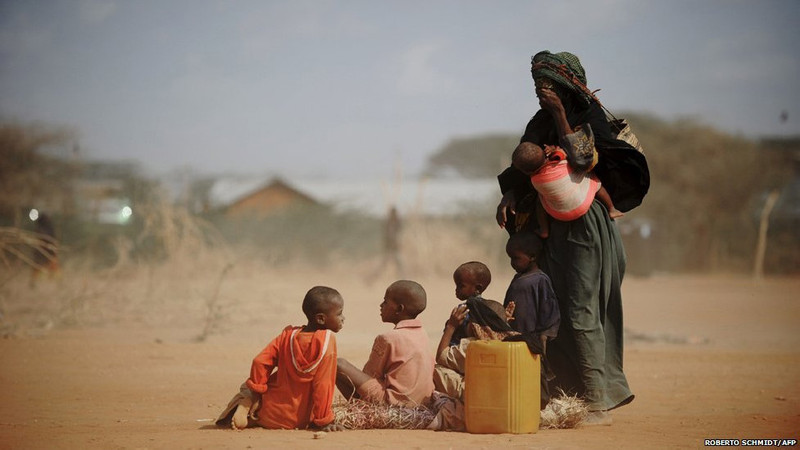
Click for details
Epidemics begin to spread
Güzel also said infectious diseases have begun to rapidly spread in the camps. “Life for the people who were struggling with poverty has gotten more difficult when the drought crisis emerged. There are no adequate supplies in the camps. Diseases rapidly spread. It is very tragic but people are waiting for their death in the camps. Eight children lost their lives within several hours during our visit to a camp where only 100 families live. Since there is no authority in the country, there are not any official figures about what is taking place. It is not exactly known how many people are living in the camps or how many people have lost their lives. There are just estimations about the possible figures.
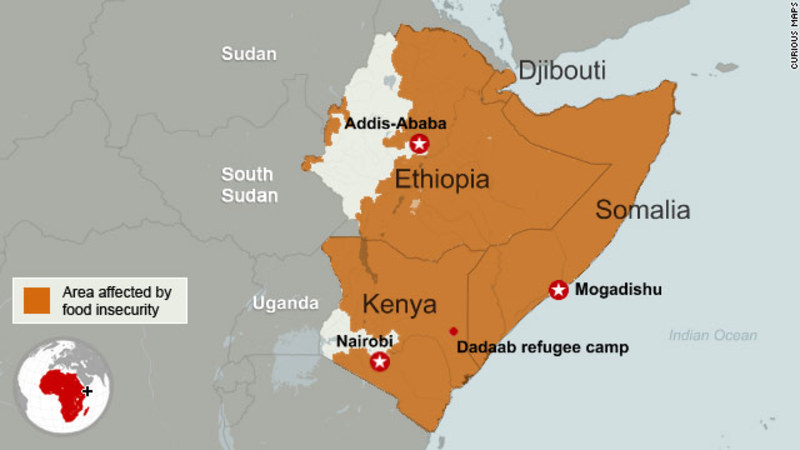
IHH took relief to 45,000 people
The IHH has delivered food supplies to 45,000 people in the camps in Somalia, said Güzel, adding that the amount of food delivered by the IHH will be sufficient during the holy Muslim month of Ramadan. He also added that the IHH will continue its relief efforts in the region.
Please click for online donation
Please click for bank account numbers
23 July 2011
Humanitarian tragedy in East Africa
People who fled the drought in Somalia and have taken shelter in camps in Kenya are undergoing a real humanitarian tragedy. These people who fled regions which received no rain over the past three years and walked for 400 kilometers under 50 degrees centigrade are trying to survive in the camps they have taken refuge. While most of the people lost their lives during this tiring journey, those who were able to make it to the camps are suffering from exhaustion, hot weather and hunger.
Click for details
Drought felt in the East African countries has reached an alarming level. It is said that drought affects 11,5 million people. People have to leave their countries due to drought and hunger triggered by drought. In Somalia which is one of the countries hit severely by the drought, people leave their houses and take refuge in neighboring countries being mainly in Kenya and Ethiopia. Currently, there are 480,000 people who have taken refuge at Kenya’s Dadaab camp. Teams from the IHH Humanitarian Relief Foundation have taken urgent action to help the drought-stricken people. A four-member IHH team has reached in Kenya and launched relief work at the Dadaab camp.
480,000 people have taken refuge in a 90,000-people-capacity camp
IHH Emergency Aid Coordinator Recep Güzel who coordinates relief efforts in the region said there is an ongoing tragedy in the camps. He said people fleeing drought take refuge in the camps; however, they face serious risks there due to inadequate infrastructure. Güzel said Dadaab camp can normally accommodate 90,000 people; however, 480,000 people have taken refuge at this camp and the number of people coming to the camp is increasing day by day. Noting that the camp is established on a large area, he said people make use of paper boxes and grass to have a place to sleep.
Walking 400 kilometers to reach the camps
Giving some information about the efforts of the IHH in the region, Güzel said: “As the IHH team, we have immediately rushed to the region in the wake of the drought and launched the necessary relief efforts there. We have given priority to the Dadaab camp in Kenya. There is now a real humanitarian tragedy at the camp. People who want to flee drought in Somalia came to Dadaab camp in Kenya by walking 400 kilometers of distance under scorching heat.”
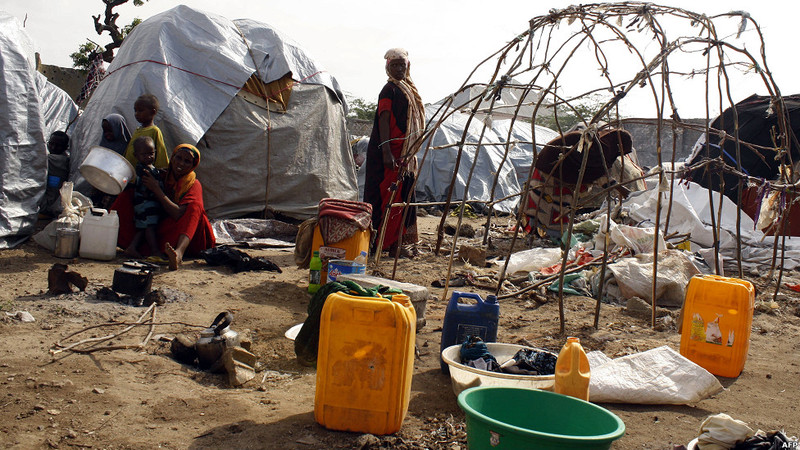
People lose their lives on the way to the camps
Güzel said some people who fled the drought in Somalia have lost their lives on their way to the refugee camps. “The journey to Kenya became a journey to death for some. Considering that families have an average of four children, the problems of the journey have become more pressing and there have been some who lost their lives on the way to the camps,” added Güzel.
Stressing that people at the Dadaab camp have their lives at risk due to the inadequate infrastructure in the camps, Güzel said: “Some regions of Somalia have received no rain over the past three years. People who have come here are dealing with many problems. There is almost no infrastructure at the camp. People sleep on paper boxes. Particularly children and the women have been affected by the walk under scorching heat. They look very exhausted and lack the energy even to move. We have given priority to improve the situation of the women and the children first. As the IHH, we have delivered 3,000 packages of milk, 2,500 packages of biscuits and corn flour at the camp.”
IHH to establish coordination center in Kenya
Güzel also noted that the IHH has launched work to establish a center to coordinate relief efforts in the camp regions in Kenya. He said the foundation will continue to make efforts to meet the needs of the people in the camps. “The IHH has sent a second aid team to Kenya. We will move to Somalia which is also severely hit by drought and coordinate relief efforts there after the arrival of second IHH team here. As far as what we learn from friends there, the situation in Somalia is worse than the situation here. They say there are dead bodies in roadsides. We will simultaneously continue relief efforts in Somalia and Kenya. Our request from our nation is not to leave these people alone ahead of the upcoming holy month of Ramadan,” said Güzel.
Please click for online donation
Please click for bank account numbers
22 July 2011
Drought turns into a humanitarian crisis in Somalia
People in Somalia are striving to survive in the midst of a heavy drought which paralyzes the daily life in the country severely. Many people in the country who had to leave their homes due to severe drought and moved to other places are suffering from hunger, which is one of the worst humanitarian crises.
Click for details
The IHH Humanitarian Relief Foundation has called on the entire world through the Organization of the Islamic Cooperation (OIC) and ZamZam Foundation, which is its partner in the region, to extend a helping hand to the country.
There is a now an influx of refugees to capital Mogadishu, where most of the houses are demolished, from other parts of Somalia due to the years-long domestic turmoil in the country. The government of Somalia announces that 1,500 new people come to the city every day but the government lacks the means to provide support for them. While some refugee groups take shelter in the ruins of the state buildings, some residents of the city invite the refugees to their homes. Various aid organizations and the OIC have called for emergency aid to the region considering the fact the region has been hit by the most severe drought of the past 60 years.
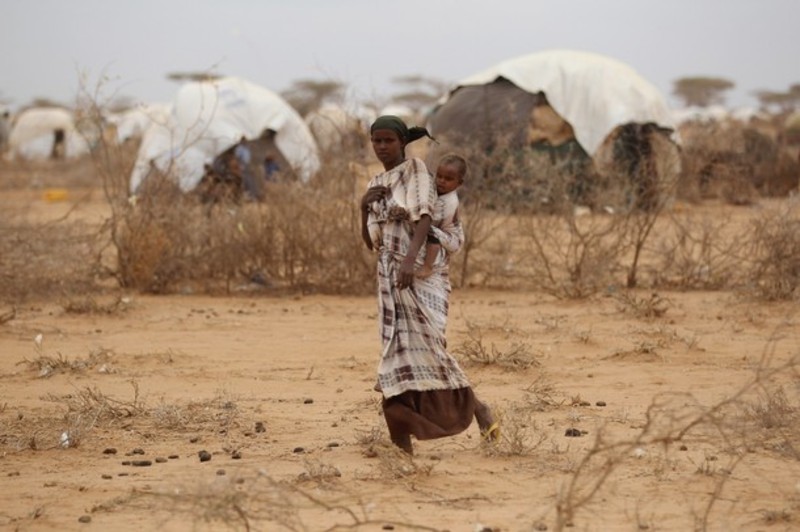
Thousands of animals have perished and there is almost no clean water left in the country due to the drought. The people who fled their homes due to the drought go to the border regions and 380,000 people strive to live in Dadaab Refugee Camp at the Ethiopian-Kenyan border. The camp is insufficient to accommodate the Somalia refugees and provide food for them. In addition to this, most of the refugees in the camp are ill and in need of treatment.
The IHH, which carries out permanent projects in Somalia, has delivered food to 7,000 drought-stricken people living in three different regions of the country. IHH’s partner in the region, the ZamZam Foundation joined the delivery of the food which included 10 tons of rice, 6,5 tons of sugar, 2,880 kilograms of vegetable oil for 1007 families.
Somalia came under the world’s spotlight with the hunger crisis in the country in the 1980s. There are growing concerns that the ongoing drought in the country will turn into famine if immediate action is not taken. The IHH speeds up relief efforts in the region and plans to take emergency aid to the country at Ramadan.
Please click for online donation
Please click for bank account numbers
21 July 2011
Droughts bring famine to Horn of Africa
Droughts in East Africa have hit Somalia the worst. Somalia is suffering the worst drought and hunger in 60 years.
Click for details
The IHH Humanitarian Relief Foundation, which has been carrying out relief operations in Somalia for 15 years, has published a report detailing the acute droughts that have hit East Africa. The report warns that if there is no adequate rainfall in the second rainy season October-November, 2012 will be the year of disasters. The foundation has sent a four-member emergency relief team to the region to carry out relief works in Somalia and Kenya, where hundreds of Somalis have sought shelter.
African countries of Somalia, Kenya and Ethiopia are going through the driest season in 60 years. The United Nations and civil society organizations in the region have mobilized to draw global attention to the humanitarian crisis unfolding in the Horn of Africa. The IHH sent a team to the region and published a report on the crisis to bring it to Turkish public’s attention.
The IHH report goes through previous droughts in the region with underlying reasons. It is not possible to explain the droughts in the region only with global warming, the report stresses, climatic conditions of the region, combined with war, intensify the impact of droughts.
The report says about $2 billion fund needed to prevent the droughts in Kenya, Ethiopia and Somalia from turning into a humanitarian disaster, and adds the droughts ravaging the Horn of Africa should be treated as a humanitarian situation, urging emergency measures.
IHH IN KENYA AND SOMALIA
A four-member emergency relief team sent by the IHH Humanitarian Relief Foundation reached Kenya, where hundreds of thousands of Somalis are sheltered. The team is carrying out relief works in the Dadaab camp on the Kenya-Somalia border that houses an ever increasing 100,000 refugees. The team will later cross into Somalia to carry on relief works there.
Click Here for Online Donation.
Click here for bank account numbers
20 July 2011
IHH teams set off to Somalia
The people in Somalia, who are subject to the biggest drought of the last 60 years, are struggling with famine and other consequences of drought. While hundreds of thousands of people have sought refuge in neighbouring countries, a significant increase in deaths due to starvation has been observed in Somalia. As a result of the severity of the situation in Somalia, an IHH team of four headed off to Somalia.
Click for details
The drought in eastern Africa has brought vital danger to the region. The drought in the Dark Continent has affected at least 10 million people. It is observed that Somalia has been the country to be affected by the drought most. The drought and drought-induced hunger caused desperate hundreds of thousands of Somalis to migrate to neighbouring countries Kenya and Ethiopia. The Somalia people, who have already been in difficult circumstances due to instability and economic woes, faced another disaster. It is stated that the number of people who are in need of emergency aid increased from 6.3 million (earlier this year) to 10 million, the majority of who are in Kenya.
The UN to declare Epidemic of Hunger
Following the ongoing effects of drought, it was recorded that the United Nations would declare an Epidemic of Hunger in drought and poverty-stricken Bakool and Lower Shabele. While 30 percent of children in Somalia are faced with malnutrition, it is recorded that four of every 10 thousand children die each day.
The last Epidemic of hunger in Somalia was declared in 1992. As a result of the epidemic of hunger during the civil war, 200 thousand people lost their lives. However it is feared that this time the number of deaths will be higher than the last time. The most important reason for the severe drought, compared to the previous years, is regarded to be the death of livestock. The majority of the Somalia people are known to be nomadic and are known to rely on animal husbandry.
The IHH Humanitarian Relief Foundation set off to the region where a human drama is being experienced. The IHH has sent an emergency aid team of 4 people to Somalia. The IHH team will initially go to Kenya and will carry out works on the Kenya-Somalia border where about 400 thousand people have taken refuge in the camps and are trying to survive. Our foundation first of all will carry out emergency aid works in the region and then will prepare a report to list what more can be done in the region following inspections. Meanwhile, we expect support from our people to the people of Somalia who struggle with hunger before the upcoming month of Ramadan.
Click Here for Online Donation.
Click here for bank account numbers